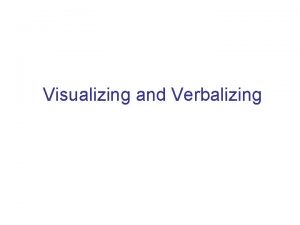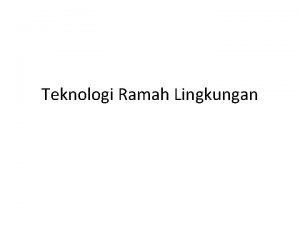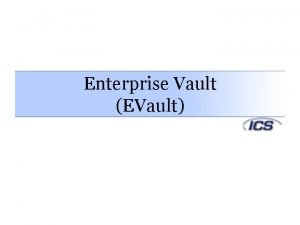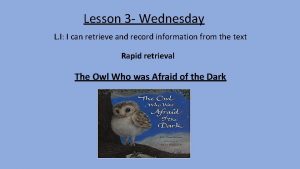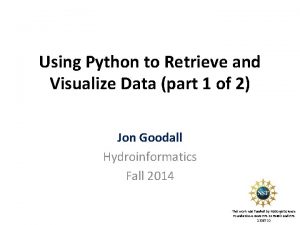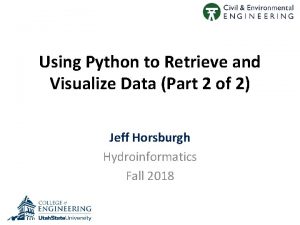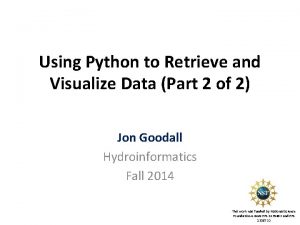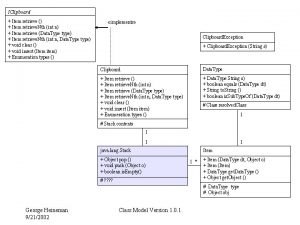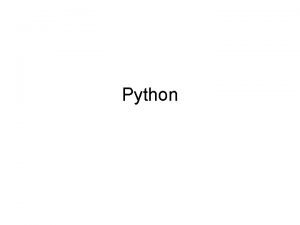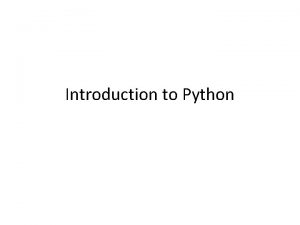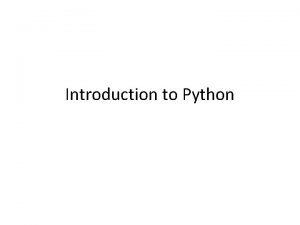Using Python to Retrieve and Visualize Data Part














- Slides: 14

Using Python to Retrieve and Visualize Data (Part 2 of 2) Jeff Horsburgh Hydroinformatics Fall 2017 This work was funded by National Science Foundation Grants EPS 1135482 and EPS 1208732

Quick Review • Last class we covered – How to create a time series plot that reads data directly from an ODM My. SQL database – How to generalize the script to work for any Site. ID, Variable. ID, Start. Date. Time, and End. Date. Time • Today’s Agenda: – – Go over the “final” script from last class’ material Show to create a figure with multiple subplots Show to use functions to organize your code Briefly introduce the Pandas package for data analysis in Python

Solution to Challenge Problems from Last Class • Open Class 15_Example_Final. py for a solution to the challenge problems presented at the end of last class’s lecture • Let’s walk through the code

One Figure, Multiple Subplots • It is often valuable to include multiple subplots on a single figure.

One Figure, Multiple Subplots • You can do this by 1) creating a figure object, and 2) using the add_subplot method on the figure object as shown below. import matplotlib. pyplot as plt # Create the plot figure that we will add 2 panels to fig = plt. figure() ax = fig. add_subplot(2, 1, 1) – First number is number of rows – Second number is number of columns – Third number is the specific plot assigned to the axes object ‘ax’ # Then plot the first subplot ax. plot(local. Date. Times, data. Values, color='grey', linestyle='solid', markersize=0)

Challenge Problem • Extend Class 15_Example_Final. py to have at least two subplots (temperature at 2 sites) • Take ~ 5 minutes to think about this, and then I will present a solution.

Solution See Class 16_Example_Subplots. py in Canvas

Using Functions to Reduce Repetitive Code • Syntax for a function in Python: def my_function(arg 1, arg 2): x = arg 1 + arg 2 return x • This function takes two arguments, adds them, then returns the sum.

Example of Creating Subplots using Functions • See Class 16_Example_Functions. py for an example of how to use functions to solve the challenge problem. • We will walk through this code in class.

Introduction to the Pandas Package • Includes classes designed specifically for data analysis and visualization including – Data. Frame – Series • See Class 16_Demo. Pandas. py for an example of how to plot a time series using the Pandas Library. • I found this blog post to be a very helpful introduction to some of the time series functionality in Pandas.

Resulting Image from Example Pandas Script Take home message: Creating a similar figure using only matplotlib is possible, but would take many more lines of code.

Assignment 5 • Now you get to try this on your own. • Build from the examples provided in class (and/or others you find online) to create your own ‘publication ready figure’ from the data stored in the loganriverodm database • Exactly what plot you create is up to you • Details for the assignment are provided on Canvas

Summary • I hope I convinced you that – Reproducibility matters and it should be a goal of your data analysis and visualization steps – Using Py. My. SQL and matplotlib, it is possible automate data visualizations with a script – There are many ways to organize your code and functions • Messy code is quick to write, but it may come back to haunt you if it is part of a larger project – Pandas library provides classes that make it simpler to handle data analysis and visualization processes. • I hope that you now have some basic concepts that you can build from using online documentation and examples – Like all things, practice makes perfect.

Resources • matplotlib gallery of examples – http: //matplotlib. org/gallery. html • Pandas compared to SQL – http: //pandas. pydata. org/pandasdocs/stable/comparison_with_sql. html • Pandas compared to R – http: //pandas. pydata. org/pandasdocs/stable/comparison_with_r. html
 Visualizing and verbalizing
Visualizing and verbalizing Visualizing and verbalizing pictures
Visualizing and verbalizing pictures Dynamics crm visualize relationships
Dynamics crm visualize relationships Visualize an acre
Visualize an acre Visualize reading strategy
Visualize reading strategy Structuralism vs functionalism
Structuralism vs functionalism Tujuan teknologi ramah lingkungan
Tujuan teknologi ramah lingkungan Five year old tammy mistakenly believes
Five year old tammy mistakenly believes Vipers explain
Vipers explain Vipers literacy shed
Vipers literacy shed How to enable enterprise vault in outlook
How to enable enterprise vault in outlook Retrieve
Retrieve Polynomial addition using singly linked list in c
Polynomial addition using singly linked list in c Pyautogui.displaymouseposition()
Pyautogui.displaymouseposition() Twitter sentiment analysis using spark streaming python
Twitter sentiment analysis using spark streaming python

